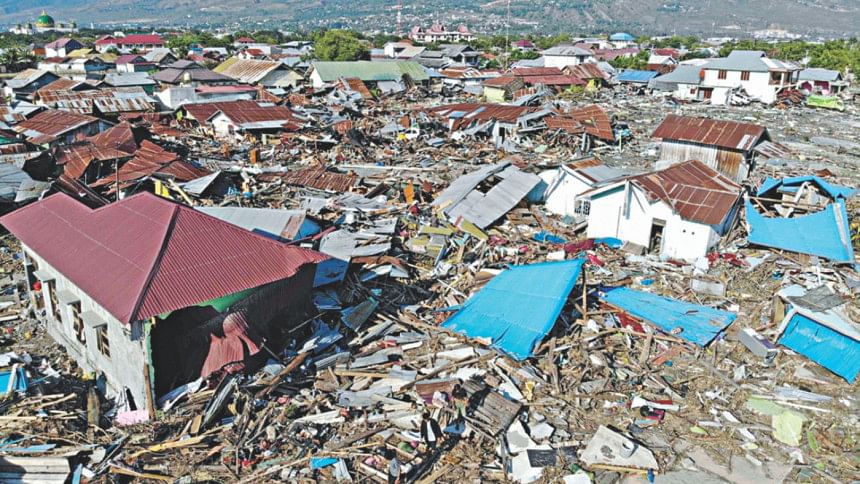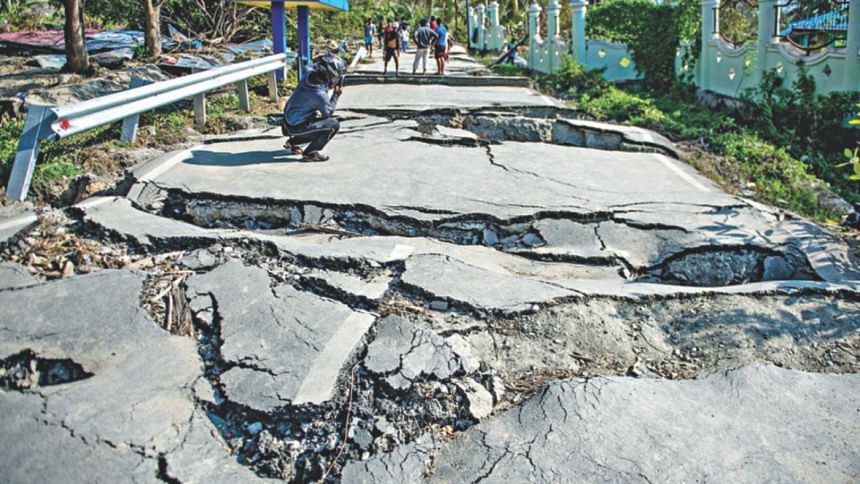Quake, Tsunami in Indonesia: Death toll tops 1,200

Indonesia yesterday scrambled to get help into quake-hit Sulawesi island as survivors streamed away from their ruined homes and accounts of devastation filtered out of remote areas, including the death of 34 children at a Christian camp.
Rescuers are racing against time to reach victims still trapped under rubble three days after the disaster.
At least 1,200 people have been killed and hundreds more feared buried in landslides from the 7.5-magnitude earthquake that hit Central Sulawesi on Friday, which was followed by several aftershocks, a tsunami as high as six metres (20 feet) and mudslides, according to data from the National Disaster Mitigation Agency (BNPB), reported The Jakarta Post.
Nearly three days after the quake, the extent of the disaster was not known with authorities bracing for the toll to climb - perhaps into the thousands - as connections with remote areas up and down the coast are restored.
Dozens of people were reported to be trapped in the rubble of several hotels and a mall in the small city of Palu, 1,500 km (930 miles) northeast of Jakarta. Hundreds more were feared buried in landslides that engulfed villages.
Of particular concern is Donggala, a region of 300,000 people north of Palu and close to the epicentre of the quake, and two other districts, where communication had been cut off.
The four districts have a combined population of about 1.4 million.
One woman was recovered alive from ruins overnight in the Palu neighbourhood of Balaroa, where about 1,700 houses were swallowed up when the earthquake caused soil to liquefy, the national rescue agency said.
"We don't know how many victims could be buried there, it's estimated hundreds," said Sutopo Purwo Nugroho, spokesman for the National Disaster Mitigation Agency.
All but 23 of the confirmed deaths were in Palu, a city of about 380,000 people, where workers were preparing a mass grave to bury the dead as soon as they were identified.
Aid worker Lian Gogali, who had reached Donggala district by motorcycle, said hundreds of people facing a lack of food and medicine were trying to get out, but evacuation teams had yet to arrive and roads were blocked.
"It's devastating," she told Reuters by text.
Indonesian Red Cross spokeswoman Aulia Arriani said a church in an area of Sigi, south of Palu, had been engulfed in mud and debris. Officials said the area suffered liquefaction, when the shock of the quake temporarily destabilises the soil.
"My volunteers found 34 bodies ... children who had been doing a bible camp," Arriani said.
The UN's relief agency believes that 191,000 people are in urgent need of humanitarian assistance in Sulawesi, according to an assessment published yesterday, reported AFP.

Sulawesi is one of the earthquake-prone archipelago nation's five main islands and sits astride fault lines. Numerous aftershocks have rattled the region.
Pictures showed expanses of splintered wood, washed-up cars and trees mashed together, with rooftops and roads split asunder. Access to many areas is being hampered by damaged roads, landslides and collapsed bridges.
A Reuters witness said queues at petrol stations on the approaches to Palu stretched for miles. Convoys carrying food, water and fuel awaited police escorts to prevent pilfering before heading towards the city while residents streamed out.
The state energy company said it was airlifting in 4,000 litres of fuel, while Indonesia's logistics agency said it would send hundreds of tonnes of rice. The government has allocated 560 billion rupiah ($37.58 million) for the recovery.
The government has played down worries about looting though witnesses have seen incidents.
Chief security minister Wiranto said more than 2,800 troops had been deployed and plans were in place to send in a further 2,000 police.
The government would accept offers of help from 18 countries and it had also commandeered 20 excavators from mines and plantations to help with a shortage of equipment to dig through wreckage and clear blocked roads, he said.
Nearly 60,000 people were displaced, many terrified by powerful aftershocks, and they needed tents, water and sanitary facilities, while the power utility was working to restore electricity, he said.
Commercial flights have yet to resume but military aircraft were taking people out of Palu. About 3,000 people thronged the small airport hoping to get out and officers struggled to keep order.
"I'd get a plane anywhere. I've been waiting for two days. Haven't eaten, barely had a drink," said 44-year-old food vendor Wiwid.
Indonesia is all too familiar with earthquakes and tsunamis. A quake in 2004 triggered a tsunami across the Indian Ocean that killed 226,000 people in 13 countries, including more than 120,000 in Indonesia.
Palu sits astride the Palu-Koro fault, which runs north-south along the edge of Palu Bay. Geologists estimate segments of the fault have a slip that is among the highest in Indonesia, at 4 cm (1.6 inches) a year, exposing the area to a higher risk of quakes.
Questions are sure to be asked why warning systems set up after the 2004 disaster appear to have failed.
Disaster agency spokesman Nugroho told reporters on Sunday none of Indonesia's tsunami buoys, one device used to detect waves, had been operating since 2012. He blamed a lack of funds.
The meteorological and geophysics agency BMKG issued a tsunami warning after the quake but lifted it 34 minutes later, drawing criticism it had been too hasty.
However, officials estimated the waves had hit while the warning was in force.

 For all latest news, follow The Daily Star's Google News channel.
For all latest news, follow The Daily Star's Google News channel. 







Comments